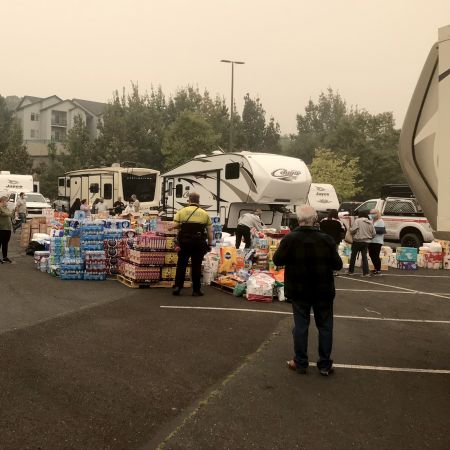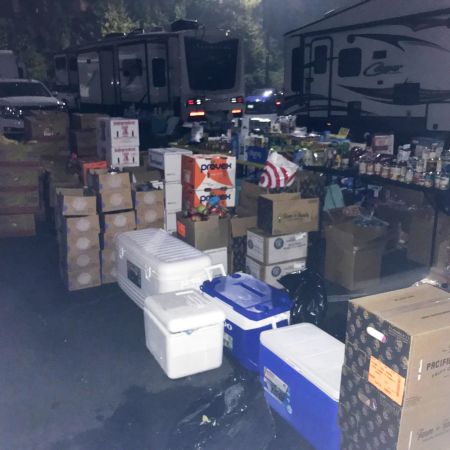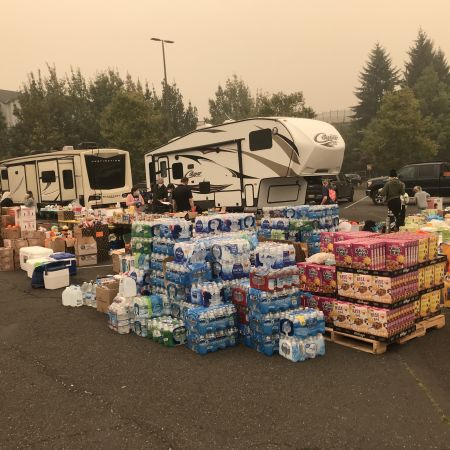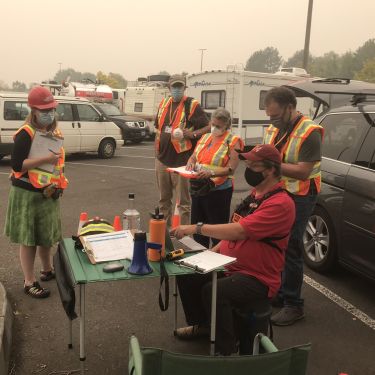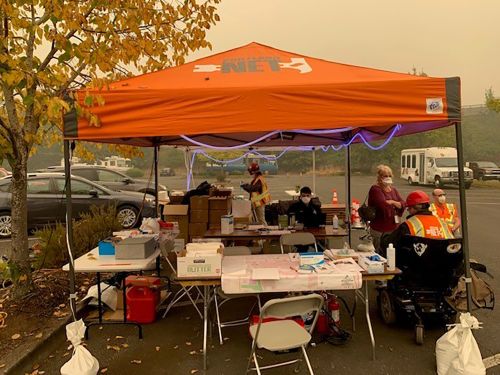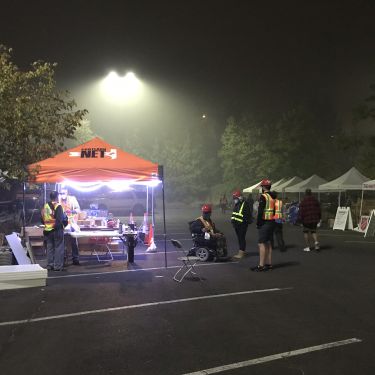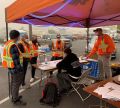2020 Clackamas Wildland Fires
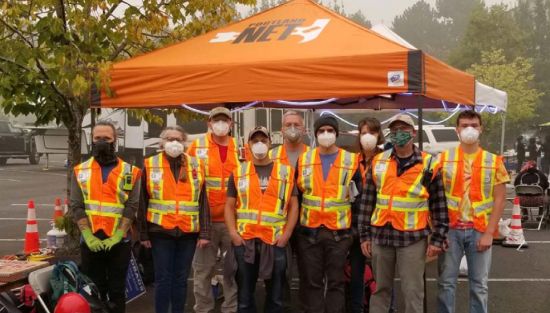
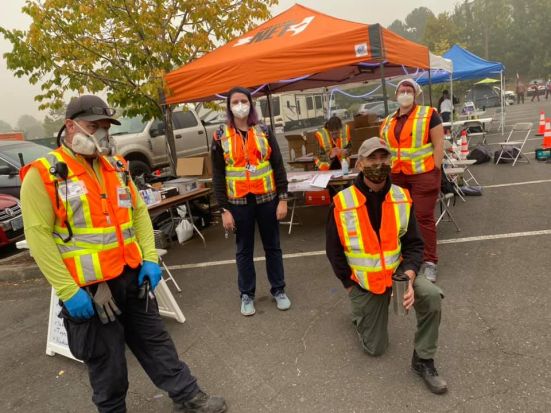
A series of large wildfires starting in mid-August 2020 and burning throughout Oregon coalesced into the state's largest deployment of wildfire response resources and one of the most destructive wildfire seasons in Oregon's history. Clackamas County was particularly impacted. "The two large fires that impacted Clackamas County were the Clackamas Fire Complex (11,210 acres) and the Riverside Incident (138,054 acres, 139 structures lost and 4 injuries)."[1] .On request from Clackamas County Emergency Management, NET volunteers operated an evacuation center from September 11 to September 18. This deployment was the first time NETs operated independently on a large incident, covering multiple response capabilities.. This NET Wiki article is a reprint of an After-Action Report (AAR) for the deployment.
NET volunteers were later mentioned in an article about the fires appearing in The Guardian.
Scope
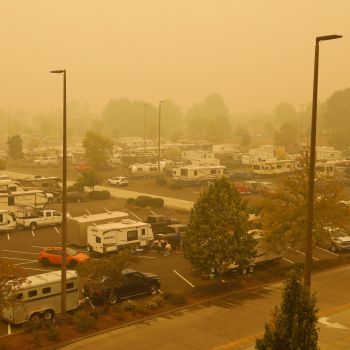
This after action report (AAR) focuses on the response of Portland’s Neighborhood Emergency Team (NET) volunteers to 2020’s wildfire siege of Clackamas County. Wildfires raged in Clackamas County from August to December, but (as Clackamas County is outside NET’s service district) NET volunteers responded to support Clackamas response efforts only as needed, from September 11 to September 19, 2020.
This AAR mostly recounts NET deployment to the Clackamas Town Center evacuation site. However, NET volunteers also served briefly at other evacuation sites: the Oregon Convention Center and United Methodist in Oak Grove. This AAR makes observations and recommendations relevant to NET volunteers, NET Team Leaders, and NET Coordinators for future deployments and exercises.
Clackamas Fire District #1 completed a more comprehensive AAR of the Clackamas Fires, available at https://clackamasfire.com/wp-content/uploads/2021/01/2021-01-21-AAR-Executive-Summary-Final.pdf.
Methodology
Assessments were requested by participants immediately after the deployment, but the AAR was not completed until June of 2021 (COVID response delayed completion) . This AAR includes the following inputs:
- Notes from an online debriefing meeting with NET responders on 09/16/2020 (recording posted HERE and embedded on this page);
- Emails shared from NET responders regarding the incident (many of which are attached as Appendix B);
- Feedback on the first draft of the AAR from NET responders, Clackamas County staff, and PBEM staff.
Background and Timeline
Assets and Capabilities
Clackamas Emergency Management
Clackamas County activated its Emergency Operations Center (EOC) on September 8, in response to the complex wildfire conflagration. The Operations Section within the EOC-ICS Structure established a Shelter Branch, responsible for coordinating the immediate shelter needs of evacuees . During the Clackamas Town Center (CTC) operation, the Shelter Branch was staffed by two Branch Managers, and supported by the Operations Section Chief. Partner agencies supported the EOC by providing two additional staff to supplement and support sheltering. The EOC deployed Clackamas County CERT teams to the CTC evacuation site as well, with the mission to assist evacuees in receiving resources and information. The Milwaukie CERT Team provided approximately 200 hours of service to the CTC evacuation site, and were active at other sites as well.
Portland Neighborhood Emergency Teams (Portland NET)
Portland NET is the largest CERT program by membership in the Portland Metro Area, with 2,164 active volunteers and over 29,000 volunteer hours contributed in 2020 . Traditionally, Portland NET operates only inside City of Portland city limits; deploying outside of Portland into Clackamas County was an unusual event. The Portland Bureau of Emergency Management (PBEM) manages NET, with selected PBEM staff assigned to oversee NET deployments. PBEM and NET aim to serve the community with a trauma informed perspective and lead responses with equity and inclusion first.
The depth of Portland NET’s bench of volunteers is key to its operational capacity. Not only does having a large pool of volunteers to draw from mean that NET can fill hundreds of volunteer shifts in a deployment (including overnight shifts), but also provides the deployment with a diversity of relevant expertise. For example, volunteer knowledge of disaster psychology, public outreach, administration, and command center setup and management all played critical roles in this response.
Clackamas Town Center
Clackamas Town Center (CTC) is a shopping center at 12000 SE 82nd Avenue in unincorporated Clackamas County, managed and co-owned by Brookfield Properties Retail Group. CTC includes 1,230,000 square feet of retail space and a parking lot with 6,800 spaces. Most evacuees occupied approximately 23.5 acres in the northeast parking lot. Inside that area, evacuees and operations were concentrated inside an area of 11.3 acres (see site map).
Brookfield Manager Dennis Curtis cooperated closely with the Clackamas County EOC to allow fire evacuees to camp at the CTC parking lot and connect evacuees to services.
At all hours, CTC security routinely patrolled the areas designated to evacuees and trespassed persons stealing supplies or presenting behavior that risked re-traumatizing evacuees. CTC Security Director Tim Harrold trains the security team in compassionate and trauma-informed approaches. This training proved important to the success of the deployment when security officers engaged with evacuees and with non- evacuees on site experiencing homelessness.
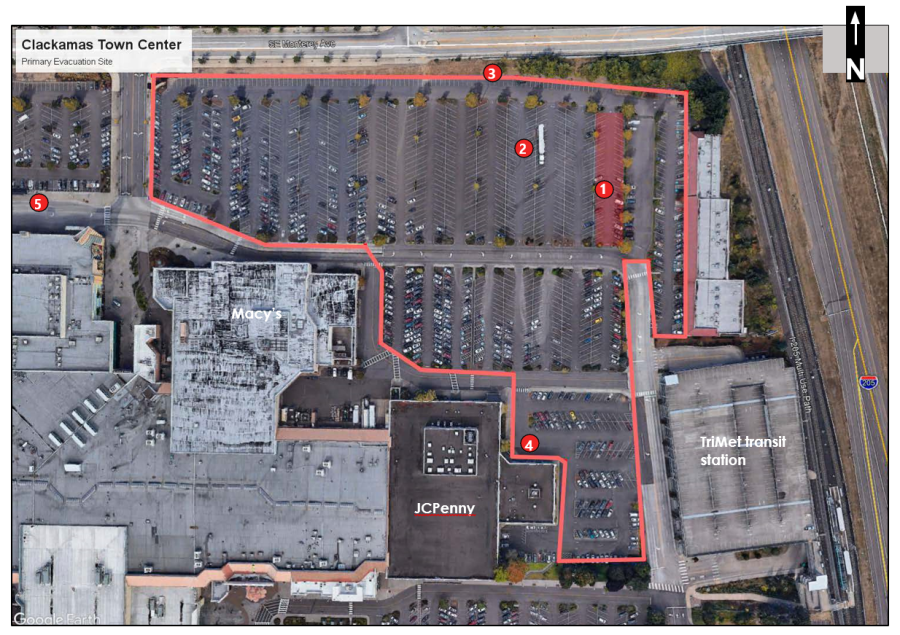
Salvation Army Cascade Division
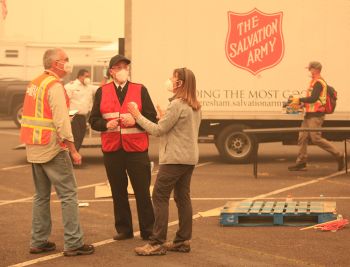
Representatives of The Salvation Army’s Cascade Division did not report on their capabilities for this after-action report. However, they provided critical aid to evacuees at CTC. On September 21, their public Facebook page reported their Clackamas County response to the fires (at CTC and elsewhere) included:
- Served Meals: 21,898
- Snacks: 13,969
- Drinks: 16,229
- Home Delivered Meals: 9,185
- Food Boxes: 1,811
- Emotional & Spiritual Care: 1,932
Background: Clackamas County Fires
On September 7, 2020, extreme heat and wind events caused major power outages and evacuation orders for areas of Clackamas County. With 15 wildland fires burning, Clackamas County declared a state of emergency on September 8. By that point, response professionals had already evacuated approximately 1,500 Clackamas County residents under Level 3 evacuation orders (“Go!”).
Clackamas County opened many evacuation sites for residents fleeing the conflagrations. By September 9, the Clackamas County EOC recognized Clackamas Town Center (as well as the Gladstone Seventh Day Adventist camp and several other sites) as an evacuation site for families in recreational vehicles (RVs) and fifth wheelers. Persons without RVs were directed to other evacuation locations. Clackamas County stood down the evacuee site ten days later at 1230 hours on September 18.
NETs were placed on standby to assist with shelter operations on September 10, at 15:38, at the request of Multnomah County (working to aid Clackamas County). NETs arrived at Clackamas Town Center at 13:45 on September 11.
The original intent was for NET volunteers to be on site twenty-four hours. However, overnight professional security hired by the State of Oregon began taking shifts the night of September 14, obviating the need for a NET presence at the evacuation site from 10 PM to 6 AM the next morning. NETs completed their last shift at CTC at 19:30 on September 17, and their last shift in Clackamas (at the Oak Grove evacuation center) at 0400 on September 19.
Volunteers took a count of CTC evacuee campsites each day they deployed (the September 12 census was later lost). A typical camp included two to five people and pets. Campsite numbers at CTC were:
| DATE | TIME | RVs + Fifth Wheelers | Tents | Cars | Others | TOTAL |
|---|---|---|---|---|---|---|
| 09/11/20 | 18:30 | 89 | 26 | 8 | 0 | 123 |
| 09/12/20 | ||||||
| 09/13/20 | 13:15 | 57 | 9 | 10 | 3 | 79 |
| 09/14/20 | 09:40 | 39 | 10 | 8 | 0 | 57 |
| 09/15/20 | 08:30 | 29 | 5 | 6 | 0 | 40 |
| 09/16/20 | 10:00 | 18 | 4 | 3 | 1 | 26 |
| 09/16/20 | 16:40 | 14 | 3 | 0 | 0 | 17 |
| 09/16/20 | 20:00 | 10 | 3 | 3 | 1 | 17 |
| 09/17/20 | 18:30 | 8 | 2 | 0 | 0 | 10 |
Overview of the Portland NET Response
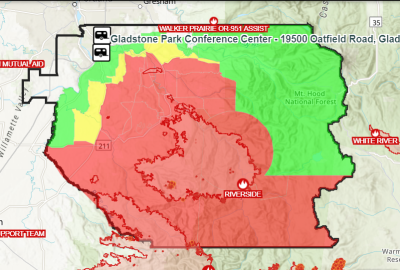
At Clackamas Town Center
- 24 operational periods (including two overnight) between 13:45 on 09/11 and 19:30 on 09/18.
- Total of 143 shifts, filled by 113 NET volunteers.
- Average shift duration was four hours and 45 minutes (except overnight shifts, which were about twelve hours long).
- NET volunteers logged a total of 668 volunteer hours responding at Clackamas Town Center.
- When deployed via Everbridge, NETs filled almost all shifts inside 30 minutes, and on average NETs filled all available shifts four minutes after the Everbridge message reached them.
- Clackamas County Emergency Management directed NET volunteers to complete the following mission objectives:
- Set up Incident Command Center on site at Clackamas Town Center (CTC);
- Act as lead coordinator on site at CTC, and the touchstone for the evacuees there;
- Act as main point of contact for people at CTC to get information and be referred to available resources;
- Refer immediate concerns back to the Joint Information Center (JIC);
- Call into the Donations and Volunteer briefings;
- Coordinate donations (i.e. turning away donations still being dropped off, coordinating pick up of donations on site with local food pantries);
- Monitor sanitary conditions;
- Monitor safety and security concerns;
- Attend Just-In-Time training as needed;
- Direct and distribute resources on site.
NETs accomplished, among other things:
- Engaging with evacuees to link them to services and information;
- Managing the shower area in partnership with LoveOne;
- Helping to develop a demobilization strategy;
- Helping to manage donations;
- Administering the phone charging station;
- Obtaining census data and other data about the temporary residents;
- Keeping out people and organizations intending to prey on evacuees;[2]
- Patrolling the site.
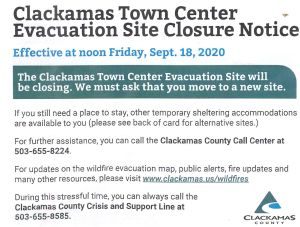
At Oak Grove and the Oregon Convention Center
The Oak Grove shelter was hosted by United Methodist, and the Red Cross was operated primarily by the Red Cross.
- 13 shifts (most of them night or overnight shifts).
- 87 volunteer hours
- Shelter operators assigned general shelter responsibilities to NET volunteers.
Overall, the response at the evacuation site went well and proved a valuable experience for participating NETs. That NETs succeeded in a scenario PBEM never specifically trained them for demonstrated the high value of preparing NETs to problem solve creatively inside accepted response frameworks and roles.
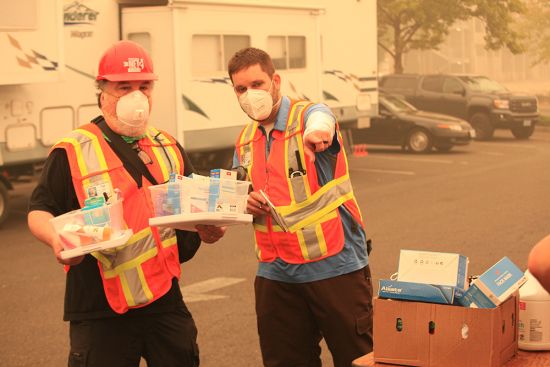
Observations and Recommendations
Observation #1: Concerning use of ICS
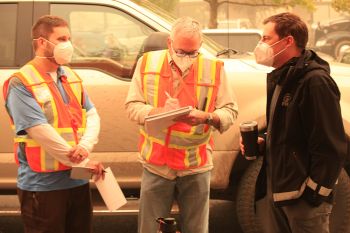
After arriving on scene, the NET Coordinator did not initiate and institute sufficient Incident Command System (ICS) practices to maintain a well organized deployment, contributing to uneven situational awareness for NET volunteers.
NET volunteers most often deploy to responses with pre-established command and ICS protocols in place when they arrive. This deployment marked the first time NETs took charge of a large, comprehensive, and multifaceted response effort outside of simulations and exercises.
This shift in responsibility, unfortunately, did not include a requisite shift in the NET Coordinator’s capacity to organize the deployment along ICS lines, occupied as that individual was gathering information and deploying volunteers. NET Team Leaders generally initiated ICS protocols themselves and kept serviceable records. But because ICS protocols were loose from the beginning, their implementation was spotty throughout the response.
As a result, transference of information from shift to shift was uneven. Occasionally, NET volunteers lacked a clear objective for their shift. Responding NET volunteers at times felt confused on responsibilities filling specific assignments (particularly helping at the showers or administering access to the cellphone charging area). Good ICS record keeping would have clarified confusion at the end of the incident around who owned which pieces of equipment loaned to the command post. NETs received good information on services to connect to evacuees, but some gaps emerged due to poor ICS recordkeeping and laxity passing on documentation.
ICS discipline would also have dispelled blurriness and produced records around specifically which evacuees volunteers engaged with and how often. Finally, NETs experienced gaps in consistent and reliable contact information for other partners involved in the response (e.g. vet response, Red Cross personnel, etc).
Recommendations:
- NET Coordinator should task specialized NET volunteers with establishing ICS protocols and documenting in the first hour of the response, including the documentation/writing of volunteer position descriptions. This will free up the NET Coordinator to manage deployments and liaise with the EOC. This may require additional training in ICS protocols and procedures.
- For future deployments, prepare a binder/log book with ICS forms that the NET Coordinator takes to the first hour of the response and turns over to the NET Team Leader to use; and, is transferred to NET Team Leaders during shift changes. A binder like this can also serve as an iterative resource directory for all volunteers to use when connecting evacuees to help. NET Team Leaders already possess similar binders, but a binder of ICS forms assigned to an incident rather than an individual is needed.
Observation #2: Concerning donations planning
Responders possessed no initial plan to manage incoming donations from the community.
The community outpouring of support for evacuees included non-monetary donations…lots of them. Donated items ran the gamut from the very helpful (such as food or sanitation supplies) to items not helpful in the judgment of any emergency manager. Many donors came to Clackamas Town Center after encouragement and anecdotes in social media platforms, such as Facebook, Twittter, and NextDoor.
Donations reflect a generous community spirit, but can place a significant burden on disaster response areas and personnel not equipped or prepared to process them. In fact, emergency managers often refer to the inevitable waves of donations as the “second disaster”, because it drains scarce response capacity and resources. Several evacuation sites around Clackamas County accepted donations for evacuees, but Clackamas Town Center was not intended as one of them. Nonetheless, donations piled up and occupied a portion of the evacuation area at Clackamas Town Center.
Evacuees at the Clackamas Town Center site, for the most part, did not need donations. Many evacuees at the site arrived in RVs stocked with supplies needed for life safety and comfort to last for days or even weeks. Of course, not all evacuees arrived with that level of resources; Clackamas Town Center also hosted evacuees who had lost their homes and everything in them, or, the RVs they drove to the Town Center were their homes and they had little to begin with. But the in-kind donations received at Clackamas Town Center largely outsized the need, and responders had no plan to manage them.
Absent a plan, donors piled up goods at two locations in the evacuation area. Evacuees, homeless persons, and others perused the “stockpile” (as it came to be called) and took what they needed. The stockpile attracted behavior not accurately described as “theft” as non-evacuees took supplies but certainly out of scope with what donors intended. For example, responders noticed several cars from outside the Town Center arrive empty, drivers filling the vehicle with donated supplies, driving away, and returning later to load up again, until CTC security or responders directed them not to return.
The scene at the stockpile was disorganized, but not chaotic, and conflicts did not erupt. But, again, that likely reflects the higher level of preparedness of many evacuees at Clackamas Town Center. A situation with more evacuees, less prepared and with scarcer resources, could result in a security situation threatening the safety of evacuees and volunteers.
To mitigate the disorganization, NET volunteers consolidated the two ad hoc donation areas into one. NET volunteers designated a throughway for vehicles near the new stockpile, blocked vehicular traffic on the other side of it, and Salvation Army volunteers staffed the area and helped evacuees find supplies they needed as “storekeepers” by retrieving items and keeping others out of the area (which also insightfully served as a COVID-19 prevention measure). NETs banned and redirected incoming donations after September 12, though the stockpile remained mostly undiminished up to the last day. Salvation Army took responsibility for remaining donations and removed them from the site on September 18.
Recommendations:
- Clackamas County Emergency Management should develop a county-wide plan for the donation of material goods from the community. The plan should include designated donation sites for Clackamas PIOs to post and share along with lists of needed items and encouragement to donors to give cash instead of goods.
- PBEM should provide a curriculum of disaster donations management to NETs and other volunteers who wish to receive the training.
- NETs and other responders should prepare a system to distinguish evacuees from everyone else and cut down on or eliminate non-evacuees from taking donations. For example, giving every confirmed evacuee a Tyvek wristband (or other identifier that can be concealed easier) that they show in order to enter a donations site (using a system like this could be extended to indicate eligibility for other evacuee services as well, such as the showers). This would also address recommendations made for Observation 5 below.
- Wayfinding signs worked well in a site as spread out as Clackamas Town Center. Clackamas Emergency Management provided dry-erase A-frame signs that helped evacuees and others find showers, donation sites, and other services. Responders should consider A-frame signs a basic need in any evacuation site that covers as much ground as Clackamas Town Center did.
- A few shots of the "stockpile", though no photos available from the event really convey how large it got.
Observation #3: Concerning Everbridge
Everbridge continued to prove a highly effective means of deploying the NET volunteers.
For years, PBEM has used Everbridge to request and deploy NETs for smaller incidents. Its use deploying NETs to the Clackamas fires only underscored its utility.
The NET Coordinator put out seven notifications to NET volunteers via Everbridge during the response period. Each notification included a request to NETs to fill 12 to 24 shifts on average. NETs filled nearly all shifts inside of four minutes after sending the request; NETs filled all the shifts after thirty minutes at the latest.
The means of message delivery deserves note as well. Over the response period, NETs collectively acknowledged message receipt 5,271 times. Of that number, volunteers received and acknowledged a deployment request via SMS 61% of the time (with 33% by voice and 6% by email).
NET volunteer Helen Chauncey noted one interesting way PBEM could improve the deployment system: set it up in such a way that NETs sharing a shift can contact each other ahead of the shift to briefly introduce themselves, plan, and get ready to collaborate.
Recommendations:
- PBEM should continue to use the Everbridge/Sign-up Genius method to deploy volunteers.
- For the most expedient response, PBEM should put SMS (both work and home) at the top of the notification method when deploying NETs.
- PBEM should consider a deployment method that allows NETs sharing a shift to coordinate ahead of time.
Observation #4: Concerning drones
Drone reconnaissance could have added value to response intelligence and planning.
The evacuation area encompassed over 23 acres where evacuees came and went freely. A complete operational picture required at least three surveys of the site on the ground each day to get a count of evacuees and track resources. NET volunteers took accurate counts and used maps effectively by redrawing them during most shifts. However, aerial shots of the parking lot taken several times a day would have provided a clearer understanding of evacuee traffic for NETs, PBEM, and Clackamas County; and, would have provided a more accurate picture quicker than drawn maps.
Naturally, deploying any drones connected to government activity should be considered carefully, and in partnership with the evacuee population if possible. Drone activity may stir up concerns around privacy rights, particularly among persons recently traumatized. How volunteers use a drone also matters. For example, a drone lifting and hovering vertically for half a minute to 40 feet, snapping a picture and then landing is less intrusive than a drone buzzing through the camp on a flight path at 15 feet.
Recommendations:
- Further develop drone operation capacity in NET to provide drone reconnaissance during deployments over large areas through training and team building.
Observation #5: Intake for evacuees
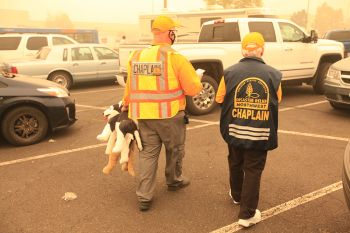
The evacuation site needed an intake process for evacuees.
Engagement with evacuees was mostly effective connecting people to resources, but uneven and sometimes duplicative with the work of spontaneous volunteers or even prior shifts of NET volunteers. This risked “outreach exhaustion” for evacuees at the Clackamas Town Center site.
As the response progressed, volunteers also noticed increasing numbers of non-evacuee homeless persons visiting the evacuation site looking for supplies and resource connections. Though NETs, Clackamas County staff, and other volunteers assisted these persons when possible, the purpose of the site was helping evacuees and NETs had no clear way of distinguishing between evacuees and chronically homeless persons.
Applying an intake process could mitigate or resolve issues like these in the future.
Recommendations:
- Assign volunteers to conduct intake interviews with everyone who arrives on site. Structure the interview to learn whether the person or family evacuated, what services they need, what questions they may have, and orient them to services available. Issue evacuees a Tyvek bracelet or other token to indicate their status as evacuees to organizations providing services on site.
- Make the intake responses and identifiers centrally accessible to NETs and Clackamas County (via Google Drive or similar cloud based resource).
Observation #6: Spontaneous volunteers enhance the response
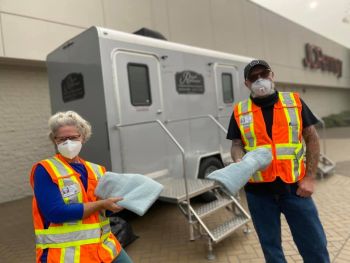
Spontaneous unaffiliated volunteers (SUVs) made highly valuable contributions to the quality of the response.
Spontaneous volunteers (SUVs) arrived at the site to help evacuees during their time of need and made many positive contributions to the response. Debbie and Joe Scott, unofficial “mayors” of the evacuation village (and themselves evacuees), provided NET volunteers with invaluable information about the status of many evacuees. Wynter Lewis served as a consistent and welcoming presence for evacuees and referred many crucial service needs to NETs and PBEM staff to solve problems. Other SUVs pitched in to help manage donations and provide other services.
Recommendations:
- Continue to provide training to NETs on SUV intake, liability, and management.
Observation #7: FRS radios helped
FRS radios served well for volunteers who brought them.
Deployment notifications to NETs recommended FRS radios for tactical communications, but did not require them. Unfortunately, several instances emerged where the command post needed to communicate with volunteers out in the field. Cell phones filled the gaps, but radio use is more immediate and all NETs should practice using them. A volunteer experienced with FRS radios noted that many NET volunteers need more practice with them, and that one person should be designated to handle radio traffic as needed.
Recommendations:
- PBEM has considered in the past making FRS radios a part of the Basic NET kit. That policy should be adopted as soon as possible. PBEM has also purchased radios for deployment use.
- Team members should check their radios before deploying, to be sure the radios are operational and full charged.
- Continue on with FRS radio training in Basic NET (unit 9).
Observation #8: NET branded PPE issues
NET vests and hard hats were not always an appropriate match for this job.
The NET Coordinator required vests, and recommended hard hats, for ease of visibility on site. Though they served that purpose, they risked making NET volunteers appear too authoritarian to evacuees largely traumatized by their recent experiences. Closer to the end of the response, the NET Coordinator suggested volunteers remove them (but keep on their NET badge/lanyard) when directly engaging with evacuees.
On the other hand, the high visibility of the vests made the volunteers easy for cars to spot. Some NETs also felt safer wearing them when doing foot patrols, particularly at night, because of their “official” appearance. So, a Team Leader should weigh the most appropriate uniform for the work at hand.
Recommendations:
- Weigh costs and consider a simple NET deployment t-shirt for NET volunteers as part of their basic kit. Some volunteers possess such shirts already, and they presented a less jarring presence than the hi-viz NET vests.
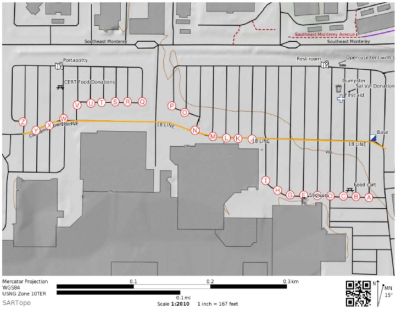
Observation #9: Map wayfinding
When mapping a site that is in a large parking lot, label the parking lot lanes to coordinate site locations.
Some NET volunteers created site maps numerically or alphabetically labeling lanes of the parking lot site. The evacuation site had no pre-designated spots and evacuees came and went freely with no check-in or check-out process. Therefore, labeling the lanes on a map proved helpful when planning the location of resources, tracking how different RVs moved to different spots on the site, or confirming that an RV or camper arrived or left the site entirely. Taking this idea a step further and marking each parking lot lane with signs would facilitate wayfinding in future deployments at similar sites.
Recommendations:
- On site maps where evacuees are camping in a large parking lot, decide on and implement a system for labeling parking lot lanes.
- Match signs to the labeling system, plant them, and use them for wayfinding throughout the incident.
Observation #10: NETs and evacuation site security
The presence of NET volunteers can effectively improve the safety and security of an evacuation site.
NET volunteers are not security officers by training or mission. PBEM trains volunteers to report suspicious persons who appear to have no productive business at an evacuation site to security officers or the police. Nonetheless, a command post managed by uniformed volunteers appeared to discourage unwanted visitors and curious onlookers. Anecdotal reports suggested that the presence alone of professional volunteers conveyed a sense of order and safety.
Volunteers enhanced this impression with regular foot patrols around the perimeter. Volunteers greeted (not confronted) unfamiliar persons and asked if they needed help. CTC security helpfully approached and intervened as needed when volunteers’ hails were rebuffed. In one particularly jarring incident, the scrutiny of NET volunteers helped chase off a person who arrived at the evacuation center impersonating a FEMA representative and told evacuees they had to leave the site. Though this offender was not caught before authorities arrived, he received an appropriately chilling welcome from the volunteers on duty.
PBEM and NET can enhance non-confrontational security simply by knowing better who belongs on site as an evacuee (see Observation 5).
Recommendations:
- Offer training to NET volunteers on non-confrontational site security techniques, and continue to make de-escalation training regularly available.
- Follow recommendations in Observation 5 to improve site security by keeping better track of legitimate evacuees.
Observation #11: NET deployment "go-kit"
When arriving on site, PBEM brought a canopy and some chairs, envisioning that is all the deployment would require (Clackamas County provided a couple tables). In a short period, the PBEM NET Coordinator found himself relying on MC ARES and NET volunteers for a generator and canopy lighting.
PBEM would do well to invest in a deployment go-kit that staff can stand up at sites such as Clackamas Town Center. An optimal go-kit could include:
- One or two 10x10 canopies;
- Dual fuel generator and propane tank;
- Multi-outlet heavy duty extension cord;
- Lighting system for the canopies;
- At least two portable tables;
- At least four portable chairs;
- Traffic control devices;
- Log book and ICS forms;
- Clipboards, pens, office supplies, etc;
- Dry erase A-frame signs and other wayfinding devices.
For more information on the equipment present at the command center, see Appendix C of this report.
- The evolution of the NET command center over the response period.
-
BEFORE: the NET command center on the first day of deployment. September 11 2020, photo by Jeremy Van Keuren.
-
AFTER: the NET Command Center on the last day of deployment. September 16 2020, photo by Lisa Jamieson.
-
The NET Command Center at night. September 12 2020, photo by Jeremy Van Keuren.
Acknowledgements
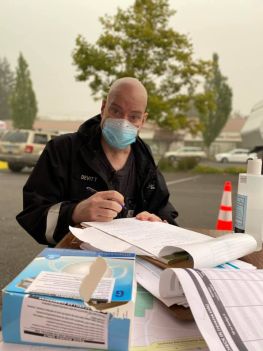
Thank you to the following volunteers, emergency management staff, and others who made contributions and other edits to this AAR:
- Molly Bradley
- Helen Chauncey
- Glenn Devitt
- Bob Fischer
- Mark Ginsberg
- Sarah Harrington
- Erik Hovmiller
- Bill Hulley
- Lisa Jamieson
- Ernie Jones
- Wynter Lewis
- Heidi McNamee
- Michael Schilmoeller
- Adam Seidman
- Tara Sprehe
Also, special acknowledgement to Deb Provo and Multnomah County ARES, Val Hoyle, and Kenny McElroy for loaning out equipment to the command post.
Kenny even let us borrow an air quality monitor he built himself (pictured below). Where was this guy when I was in eighth grade and all I got for the science fair was a “Participation” ribbon?
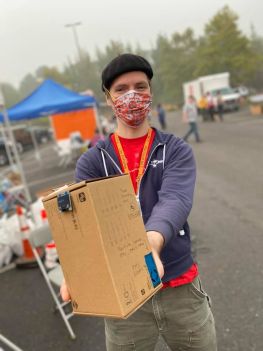
Appendix A: Photo Gallery
A few more photos of the deployment that did not go into the AAR appear in the slideshow gallery below (if it the gallery doesn't appear, hit "refresh" on your browser).
Appendix B: Volunteer Hours Record
At the Clackamas Town Center evacuation site, 123 NET volunteers filled 156 shifts (98% of all shifts posted). NETs also filled shifts at the Oak Grove shelter and the Red Cross shelter at the Oregon Convention Center.
Click "Expand" to view all shifts.
Appendix C: Abridged Volunteer Feedback
Mark Ginsberg
2020.09.14 report from Mark Ginsberg (via Amanda Westervelt):
Mark Ginsberg talked about deploying to Clackamas Town Center to work the evacuation center there. Talked about what to bring and how he gears up but then only needed a pen, paper, forms, and a notepad. Spoke about using team to run perimeter, managing a disruptive visitor who was high, dealing with miscommunications, helping with showers and distribution of masks, SUVs, etc. A very interesting discussion with some insightful suggestions. Noting the challenge of being deployed while wearing a mask and also needing to drink water, the importance of maintaining decorum appropriate and sensitive to the situation those being helped are in, and the fact that sometimes you’re in charge of people with more experience than you have (in his case, Marcel Rodriguez), but it works and you just do your best!
Bob Fischer
2020.09.16 report from Bob Fischer:
I think it is super important that PBEM and Portland recognize this was the kind of deployment that NET was never trained for. But, we took our other emergency response plans, training and experience and improvised on the fly. And it ended up with a damned good job. NET is a bunch that knows something about responding to emergencies and how to improvise. Please get others to recognize this.
To work an operation like this as a lead role, you need careful census and ID of who is in the area and mapping (numbers, ages, vulnerabilities). We did this one on the fly … but what Michael [Schilmoeller] sent in was moving toward the gold standard of how to address this kind of situation If NET is ever expected to play this role again, this kind of census data is invaluable.
Lisa Jamieson
2020.09.17 report from Lisa Jamieson:
I think documentation/communication over time was the weak point.
I suggest a log book, to be kept by the team leader and passed along to subsequent team leads. All NET activity: patrols, contacts with anyone (in this case evacuees, other service providers (Salvation army, Red Cross, Mental health, mall Security) should be documented with contact phone numbers, and it should be clear who wrote each log entry, so they could be contacted for clarification later if needed. It would probably work best to create a form, so that all the info is included. (Time/date, event or contact, any contact info, follow up needed/completed)
Sarah Harrington
2020.09.17 report from Sarah Harrington:
The only feedback that we’d have is (and we passed this on to our team leader), it would have been nice to have some kind of portable lantern where we were stationed. We made do setting our helmets with headlamps on the table.
Also, we had one disabled person come to the showers. It would have been good to ask, “Do you have any disabilities that might require assistance or extra time?” For those that couldn’t navigate the stairs, it would have been nice to have another option to point them towards. In our case, it was someone missing an arm, and they had a hard time working the faucet. It turned out it was having a problem, so doubled their frustration. After that, we added the question as people left, “How was everything?”
Tom Boeker
2020.09.17 report from Tom Boeker:
I feel that the greatest issue we faced was documenting and managing the flow of information. I would interested in participating in a group to work on this issue.
Also, our NET basic training was a great stage 1 learning - learned a lot. But I think a important message to NETs is that, stage 2 learning, the best way to learn deployment is to do a deployment.
Finally, this evacuation might be the best available analogy to what we might expect in a earthquake scenario.
Heidi McNamee
2020.09.17 report from Heidi McNamee
We were there for the very first shift, so it was all about site size up and mapping. Creating the physical map and knowing where things were on-site was the obvious but perhaps less important aspect of size-up.
The deeper size-up was understanding who was on the site and what knowledge, needs and expectations they held. In addition to several hundred evacuees, shoppers and mall employees, there were many different people providing different services: Salvation Army, Clackamas CERT, Northwest Baptist Disaster Relief, Rotary, Clackamas County Go Teams, a group of folks wanting to deliver support items to firefighters and a constant stream of lovely random people wanting to drive up and drop off supplies.
Dylan and I marked the alpha/numeric street grid for the map. We also facilitated connecting people: A Go Team volunteer with deep history of the site and no one to offload that important info to, the mall General Manager who needed to make his needs & resources known, people without a car who happened to be visiting town from Lincoln City who needed to get to the Convention Center for shelter and on and on....
Each one was a mutual size-up: what are your needs, your resources, your skills, your effectiveness. It was on-the-fly relationship building because people need a certain level of shared agreement and trust before they can work collaboratively under stress. Knowing chain of command or “who you know that I know” for the volunteers was one way to kickstart relationship with each other.
In talking with the evacuees, keeping focused on their needs (expressed verbally or with body language) and being as centered as possible was key. You could make a good guess at which volunteers had been on this sort of deployment before and who, like me, had not! It was my first deployment for an evacuation and that has a level of excitement; I had a sense of “I’m doing something useful”, it was nice to see NET buddies and I held an underlying level of anxiety with the uncertainness of the experience. All that “amped up” feeling was not useful when talking to people who were somewhere on the “fear-worry-relief-what in the world is next” spectrum and I worked to mitigate it.
Although there were people accepting donations, when NET arrived there was no real ownership or plan for what to do with all the stuff. Mall management was concerned that it would get out of hand and NET worked with the other on-site groups to form a plan. This is what Jeremy calls the “second disaster” because managing all the ‘stuff’ takes a lot of people-power.
Helen Chauncey
2020.09.18 report from Helen Chauncey
Overall, an excellent experience. Any of the following observations might strengthen our capacity – it’s worth noting, though, that the deployment was highly realistic; any of these shortcomings could well be exactly what we will be working with in a major, regional disaster. Learning to cope and pinch hit is also a valuable skill set.
Possible Improvements
Shared contact information for shift team members
- On site, we used phones for this; putting together the group text was done on the fly, which increases the potential for errors.
- If the system – whatever that is – could send out something like a contact list with emails, we might have better coordinated in advance (radios, for example) and after-action would have been easier.
Information transfer from shift to shift
This is distinct from a general briefing (as in “Here are the supplies. This is what our Salvation Army colleagues are doing.” Etc.)
An example: Tuesday afternoon, we had a canine medical issue. We phoned PAWS, which had a flyer on the table. The person we talked with wanted to help but didn’t know how. We phoned Oregon Humane, with the same result. Later it developed that both PAWS and Oregon Humane had had people on site
on Monday. (So they themselves didn’t have water tight information transfer.) Apparently by chance, Clackamas Dog Services then showed up – with a specific list of dogs on site needing services. They perhaps got this information from the Tuesday morning crew. We didn’t know how they got that information.
1) White board or cumulative, 3-ring binder:
One solution – a large white board or a large three-ring binder, as distinct from the various pads of paper, could have helped here. (Note – there is really no ICS form for this. And maintaining it would require some discipline.)
2) Longer overlap between shifts for team-to-team debrief:
More time for overlap with each shift would help, with a particular emphasis on “open cases” – dogs needing a vet; people needing housing vouchers; etc.
3) Written information sheet – contacts and protocols
Also helpful – a written sheet with information on basic services (How does the phone charging station work? Who opens and closes the showers? Who handles housing vouchers? Etc.)
The information sheet, to the extent possible, could include relevant contact information (Site security. County EOC. Addresses and phone numbers for sites to which evacuees were being sent from CTC, such as Gladstone. Other.)
Intra-team communications
Team members should ALL bring FRS radios. (Basically, there weren’t any for the Tuesday afternoon shift.) We had several instances where we needed to communicate with team members at considerable distance from the command center. Because cell phones worked, we could handle this but radios would have been less fiddly and good practice for when cell service is down.
Chief Pooh-Ba
This is a big one. Jeremy did a spectacular job of filling this role. If he had not been on site, our ability to provide meaningful services to those most in need would have dissolved.
So, how to address this, assuming JVK can’t be everywhere, always? JVK did give us the phone number for Allegra (I gather this is her/their first name) at Clackamas EOC and emailed our TL (me) a list of other contact numbers.
What we didn’t have, though, was a briefing as to what we could call whom about. (As an example, when JVK was not at the command center, would it have been appropriate for us to call Allegra if someone needed a housing voucher? JVK was sending information to her, I gather, by email. Could we text her? Send email from our phones? Other?) This same set of questions held for the additional contact phone numbers.
A briefing as to how, and to what extent, we could step into this role, in JVK’s absence, would have been very helpful.
Other Observations
Cell phones and the Internet
Both were working. This allowed us to look up information on the fly, in the absence of a more detailed briefing. (What’s the number for Oregon Humane? What’s the address for the Gladstone RV park? What’s the name/address of the church down the street, taking evacuees in cars. Etc.) In the absence of the Internet, our capacity to provide these services would have been severely weakened.
Resources guide
Would it be possible to develop a resources guide, drawing on this experience, which the NET teams have hard-copy in case they deploy under conditions where there is no Internet. Definitely, there could be no guarantee that the same partner organizations (for food, housing, animal care, medical assistance, etc.) would necessarily be available. But a contact list, periodically updated, would be a valuable start.
Spontaneous volunteers who knew more than we did
The glowing example here is Wynter (her first name.) She came out of nowhere, took to her service role with a passion, and basically kept us focused on people in need of services – filling a role we could not have filled easily – possible not at all – ourselves. Wynter was basically our “written” inventory of actual people – names, family circumstances, particular needs – as we moved through our shift.
Gear
We were basically well-prepared, apart from the absence of radios. The one item I am going to add is a NET t-shirt. I did not have anything “neutral” to wear – that did not have a tag-line from some other volunteer activity. The safety vests covered this up, but there were instances where approaching people without the vests might have been the way to go. I had previously considered the NET tees a kind of swag (a perfectly OK thing, but not essential.) I’m now thinking of them as a deployment item.
Hard hats were unnecessary. Apart from that, the prep list was spot on.
The NET call debrief – increasing participation
A few people tended to hog the show on this, possibly including myself. This may have quieted others, which is too bad. Would it be possible to send out an email to those who deployed, specifically encouraging them to send in after-action feed back? It would be great to get more voices in this discussion.
For future debrief calls, the approach taken recently – a list of names put in the chat; then people called on in order – might help here. This removes back-and-forth, but addresses the verbal dominance issue and encourages quieter voices to speak.
2020.10.12 Further comments by Helen after reviewing the draft AAR
Comment One – Authority and Responsibility
The emphasis on getting ICS correct in the AAR is valuable but doesn’t capture a concern several of the TLs expressed on the Wednesday NET call, including myself. Essentially, we need a clear articulation of authority and responsibility – both of these. These two over-arch the specific ICS designations (planning, ops, etc.)
Both at CTC and on the call, you mentioned that we (NET) were “in charge” of the evacuation site. What does “in charge” mean? What authority comes with this?
There are many examples. We were not in charge of assigning hotel vouchers, for example. I assume we could not have ordered the Salvation Army people around. And so on. What exactly were we in charge of?
Importantly – this is the big one for me – what responsibilities come with that authority?
The AAR mentions the need to conduct a more orderly check in of the evacuees. That’s a good example. But what else?
Here are two “opposing” possibilities:
Mark and Marcel’s group assumed they had the responsibility to check on the SUVs’ credentials – whether or not those SUVs checked in at the NET tent. (One example was an evacuee offering basic first aid, although her actual skill set was as a phlebotomist. My understanding is they felt they had to rein her in.)
During my shift a water truck showed up. It did come by the NET tent. I told the driver we were happy to see him. Plausibly, though, the water truck guy could have been peddling contaminated water.
Should I have confirmed that he was actually contracted by Clackamas EOC? If so, how? If the driver didn’t have proper paper work, should I have ordered him off the site? And if so, how? What was my responsibility here?
Apart from a more orderly check in system for the evacuees, what were our responsibilities to the people and animals sheltered at the site?
We may encounter this same question at neighborhood deployment areas after a natural disaster. Is our authority at those sites – before more professional first responders show up – spelled out anywhere? And with that authority, what are our responsibilities? What are we obligated to do, if we accept the authority on offer?
Comment Two – Drones
This is in your AAR draft. I don’t remember it coming up in the NET call discussion, but it might have.
I have serious reservations here, unless responsibility and cultural sensitivity are spelled out far more clearly than they currently are in the AAR and any future NET guidelines.
If you are lost and you see a SAR drone in the sky, you can reasonably assume the drone is looking for you and you can rejoice.
Otherwise, especially if you are a frazzled, anxious evacuee – particularly in America’s current, highly polarized political climate - you can reasonably assume the drone is Big Brother. It’s up there, noisy and intrusive, reminding you that you don’t have an iota of privacy.
At the very least, drones spy. For some immigrant members of our community, drones will have been the source of much worse than spy eyes. They are stealth military tools, with no human mercy, which have been widely used in conflict zones.
I understand the value of drones, responsibly used. But if I am unhappily huddled in an evacuation site, anxious and angry at my fate, and some clown starts peering down at me from a bloodless drone, I’m going to pray to whatever god I can find that someone shoots that thing down, legal penalties notwithstanding.
Also - I know you know this, but as a reminder - for anything other than a hobby, no matter what the need, your operators must be FAA licensed or operating under what’s commonly called a sheriff’s waiver. There are no exceptions to this, as far as I know. And if you go with the waiver option, you – not the operators – are responsible for what the operators do. This business of the two-faced nature of drone technology is serious.
Adam Seidman
2020.10.06 report from Adam Seidman
- It would have been helpful to have a master contact list that had key phone numbers of people like you, the folks at CTC and CC, and maybe most importantly the other Team Leads.
- For future deployments I’d recommend overlapping the Team Lead shifts so there is enough time for a proper hand-off. I’d think 15-30 minute ‘hand-off’ window would make sense.
- I think you address this in your first observation/recommendation, but it was unclear sometimes how to interact with ECC during the deployment. Mike was there for most of my shift and he was great, but clarification on that interaction would be helpful in the future.
- A master binder is a great idea and would have been helpful, especially for continuity and also to better understand the tasks/issues/etc. Again, I’d recommend that in the binder would be a key contact list.
- The drone is an interesting idea, could have been good for this deployment. Obviously has to be weighed against potential privacy issues people would have maybe had in this situation.
- I actually think our orange vests were helpful as it made it clear to folks that we were there to help and had some authority. I don’t think any of us wore helmets in our shift.
- Although most of our team had radios, I sometimes didn’t hear when people were trying to contact me. An ARO from our neighborhood team recommended that in the future I use the earpiece with the radio, which I think is good advice at least for Team Leads/ICs.
- Lastly, I found that all of the NET practice and training actually had us fairly prepared for this incident, at least in my limited view of the situation. We had people paired up in the buddy system, we used our radios for comms as needed, we had a scribe and filled out forms, and administered first aid a few times as well in my shift. So kudos to the things we’re doing in the neighborhood practices, scenario village, basic NET training, etc.
Erik Hovmiller
2020.10.07 report from Erik Hovmiller
I can’t remember much about my night there but I distinctly remember being very thankful for my NET vest and its hi-viz character. I affirm the risk of it appearing too authoritarian but it was very reassuring to me in two critical ways which I implore you to consider:
- There were motor vehicles coming and going all night and I simply needed to be seen and not worry so much about dodging vehicles that--due to the late hour on a Saturday night--I could not trust. Safety first, bro!
- Also a safety consideration of another sort, the vests exuded some weak authority--just enough authority, I think--to make me appear official but not threatening to the people passing through the site that even I, big strong man, felt some intimidation from. Being on a patrol of this massive site, virtually alone except for my one partner, was a bit scary. We were all brave though and did what was asked and in support of your goals. However, that NET vest afforded me some reassurance and confidence that folks who may consider causing trouble would possibly be a bit more respectful--and hopefully decide to leave me alone.
- And that leads to a bonus point, Jeremy. Patrols should not have been done with only two NETs during the evening around the entire CTC parking lot. 2 NETs was safe for Areas A and B (if I remember those correctly) but not to traverse to the other two approved sites which were virtually unused. That said, those long walks around the whole parking lot were very useful for keeping us awake. Always two sides...but safety first!
Appendix D: Site Inventory
| RESOURCE KIND | QUANTITY | DETAILS |
|---|---|---|
| Mobile showers | 1 | Three-stall |
| Tables | 14 | |
| Chairs | 28 | |
| Canopies | 7 | 10’x10’ |
| Portable johns | 8 | |
| Handwashing stations | 5 | |
| Security guards | 2 | Overnight shifts |
| Charging station | 1 | |
| Dumpsters | 4 | 20 yard capacity |
| Signage | 8 | Dry-erase A-boards |
| Fire extinguisher | 1 | |
| Space heater & propane tank | 2 | |
| Tri-fuel generator | 1 | Honda EU2200i (converted) |
| Light string for canopies | 1 | 50’ |
References, Notes, and Supplementary Reading
- ↑ Clackamas Fire District #1. (2021). 2020 Fire Siege: After-Action Review.
- ↑ For example: faith organizations arriving to proselytize (instead of helping) and persons testing security and casing the area. There was also one incident of an individual impersonating a FEMA employee and telling evacuees they had to leave.
Supplementary Reading
- Oregonian/OregonLive, J. G. |., & Oregonian/OregonLive, S. S. |. (2023, February 22). Oregon wildfires evacuees spill from Clackamas County, seeking refuge in RVs, shopping malls. Oregonlive. https://www.oregonlive.com/news/2020/09/wildfires-send-evacuees-spilling-out-of-clackamas-county-seeking-refuge-in-rvs-shopping-malls-fraternal-lodge.html
- Oregonian/OregonLive, J. G. |. (2023, February 22). Wildfires in Clackamas County threaten more than 600 homes and other structures; thousands of people ordered. Oregonlive. https://www.oregonlive.com/news/2020/09/wildfires-in-clackamas-county-threaten-more-than-600-structures-thousands-of-people-ordered-to-evacuate.html
- Reuters. (2022, September 19). How a 'Hillbilly Brigade' saved an Oregon town from raging wildfires. Reuters. https://www.reuters.com/article/idUSKBN2682OE/
- Riverside fire. (2021, July 29). ArcGIS StoryMaps. https://storymaps.arcgis.com/stories/7ba1715929bb4cc591b3bbade3e30895
- Stern, J. E. (2023, November 1). How civilians saved their Oregon town from two megafires. The Atlantic. https://www.theatlantic.com/magazine/archive/2021/10/oregon-town-wildfire-beachie-creek-riverside-megafires/619817/
- Van Der Voo, L. (2020, December 24). Heat, wind and a cruel twist of nature: inside Oregon’s nightmarish wildfire season. The Guardian. https://www.theguardian.com/world/2020/dec/22/oregon-2020-fire-season-smoke-coronaviruus
- Wikipedia contributors. (2023, December 22). 2020 Oregon wildfires. Wikipedia. https://en.wikipedia.org/wiki/2020_Oregon_wildfires
